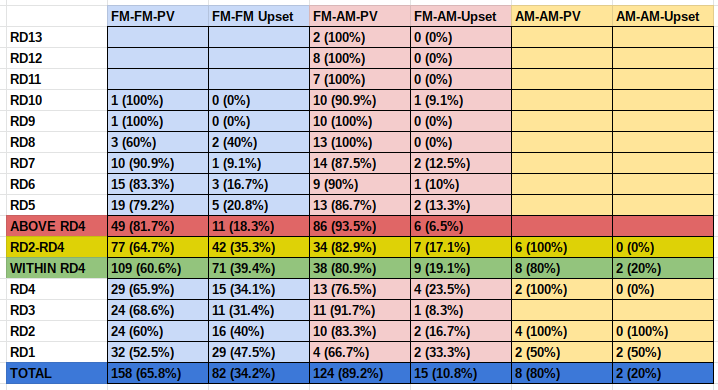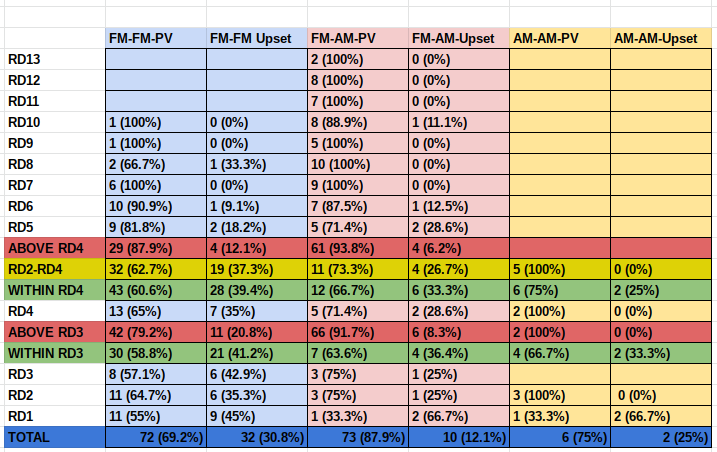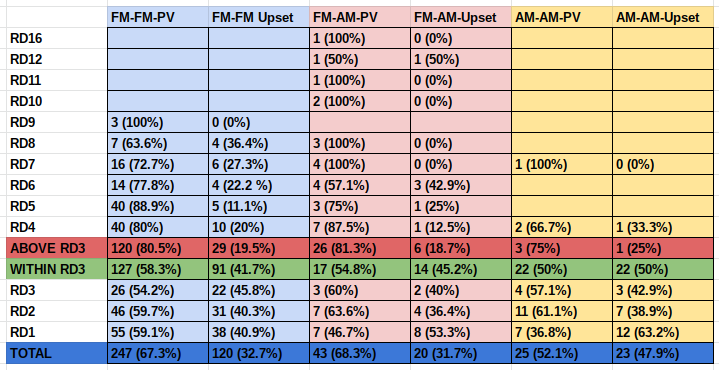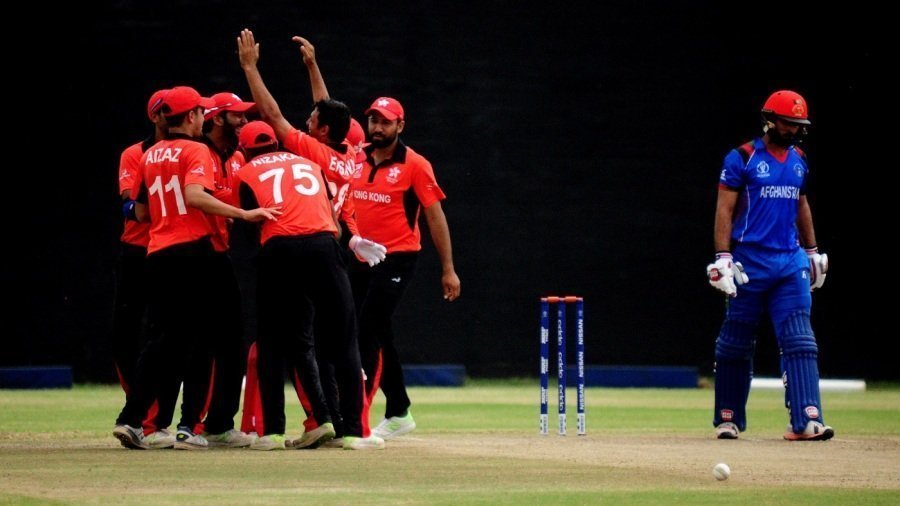This is the comprehensive analysis of competitiveness in men’s ODIs. A condensed version is available here.
The Cricket World Cup’s league phase is finally entering the home stretch, plodding dutifully along to its largely predictable conclusion like a loyal pack mule weighed down by the ICC’s bags of TV gold. The stubborn halfbreed of a trophy and a league, 2019’s CWC endures rather than excites, resolutely trudging ever-onwards when lesser, more impetuous tournaments would have long since moved onto the excitement of second rounds or knockout stages. And while this ascetic format, devoid of indulgent unpredictability, may be an interesting metaphysical exercise in self-denial, it certainly doesn’t make for compelling viewing.
For a format that was touted as driving non-stop excitement, England and Wales 2019 has been neck-and-neck in the damp squib stakes with the last time cricket’s flagship event was contested in Blighty, the notorious 1999 edition. Certainly the unseasonal weather during the early rounds didn’t help, but the tournament structure was flawed from the outset (as analysis by Russell Degnan has shown), and the assumptions underpinning the ICC’s now-pilloried promises of competitiveness were arrant nonsense; for the 10-team format to produce a compelling tournament, the ICC needed lower-ranked teams to buck a significant statistical trend against upsets and win enough matches against their more fancied opponents to keep the group stage open. As it stands, three of the four semi-final places appear to have been locked in since the halfway mark, while the fourth is realistically open to three teams – and that only due to red-hot favourites England finding new and inventive ways of disappointing their fans. As a ploy for generating excitement, relying on the #1 team forgetting how to play is a low-percentage approach.
Broadly speaking, the 10-team format is justified on the grounds that a more inclusive tournament somehow dilutes the quality, while restricting entry to the cream of the crop would guarantee those elusive “competitive matches”. Conversely, proponents of the format will point to one-sided drubbings meted out to the likes of Bermuda as evidence of why Associates are just getting in the way. Putting to one side the fact that Bermuda have not been within a division of qualifying for the World Cup for over a decade, I’ve written at length in the past to rebut the notion that top teams are any guarantee of close matches. Associate Members are certainly thrashed quite a lot, but not hugely more than Full Members thrash each other (and indeed, since the 2015 World Cup, matches between Full Members and Associates are significantly less likely to result in a blowout than matches between Full Members only).
However, margin of victory is not the whole story of competitiveness. One of the more compelling arguments against my research on “competitive matches” is that while AMs may be capable of narrowing their losses to a less embarrassing margin, they still usually lose; and despite the margins of individual FM-only matches mostly being one-sided, the matches are regarded as competitive overall because both teams are capable of winning. Basically the problem is not with one-sided matches per se, it’s merely that Associates don’t win enough.
The other perceptive criticism of my method is that the gulf in quality between top-ranked Associates and lowest-ranked Full Members has narrowed to the point of being virtually nonexistent, so membership status is an overly simplistic way of categorising results.
Consequently, I decided to examine the competitiveness of both FM and AM matches in terms of their results rather than margins of victory, tallying up the number of times higher-ranked teams were toppled by less-fancied opponents. In doing so, I was able to incorporate an investigation into the predictive power of rankings (as opposed to membership status) on the winner of any given cricket match.
The first dataset I looked at was the results of all completed Cricket World Cup matches from the first edition in 1975 through to the last edition in 2015, and I counted upsets and predicted victories between FM-only matches, FM-AM encounters and the rare FM-only matches.
[NB: I counted teams based on the official ICC rankings as they stood at the beginning of each tournament. For years prior to the introduction of the ICC ranking table, I used the ICC’s historical team rankings calculator. 1975 and 1979 were both played before historical ODI rankings, so I used the historical Test rankings instead, since ODI cricket was still in its infancy and not played or viewed particularly differently. For the purposes of this data I counted ties as upsets (since the predicted winner failed to claim victory against their lower-ranked opponent), and the solitary case of an Associate beating a lower-ranked Full Member (Kenya’s 2003 win over Bangladesh) was classed as an upset. For Associates not included on the official ranking table, ranking was assigned based on pre-tournament seeding or results in the qualifying tournament, if no seeding was available.] That gives us the following results:

At first glance, the overall numbers would seem to lend credence to the arguments of the “Associates can’t compete” camp, with the percentage of AM victories over FMs barely scraping into double figures. However, despite causing upsets at triple the rate (though, it must be acknowledged, with significantly more than triple the funding from the ICC), the higher-ranked Full Member team still wins 2/3 matches, which immediately raises a question, and one which has never been adequately answered by those complaining of Associates being uncompetitive. Namely, how many wins are enough? If 11% is not good enough, but 34% is acceptable, how many extra victories do Associates need before their presence is tolerated?
And once we start digging into the data, the situation begins to look a lot more complex. As we can see by comparing like with like (i.e. teams ranked similarly), the upsets are not evenly distributed. Unsurprisingly, teams ranked more closely are more likely to produce upsets and teams ranked further apart less likely; however, it’s not a linear scale as might be imagined. FM teams within a single ranking place are very evenly matched, producing upsets in 47.5% of encounters, then there is a gap and some bunching, with teams ranked 2, 3 and 4 places from each other all scoring remarkably similar upset rates for an average of 35.3%. But once the rankings gap passes 4, competitiveness nosedives, with underdogs of 5 or more ranking differences (RD) managing to win just 18% of their matches.
Interestingly, the same trend appears for Associates, lending credence to the hypothesis of rankings being more relevant than membership status. It also reinforces the question of how many wins are “enough”, because while AMs do still produce fewer upsets than comparably-ranked FMs, until they fall off the cliff of RD4 they hover just under a 20% chance of winning (compared to the 35% for FM-only matches).
In my previous article investigating margins of victory, I found a significant trend towards less competitive cricket in the present era. I also noted that both playing structures and administration at the early end of the data, when the majority of teams were barely even professional (and the idea of expansion was little more than a novelty), were vastly different, so numbers taken from that time would be of less use when studying cricket today.
As such I chose to focus on 2003 onwards to give a representative sample of modern cricket, especially within the Associate context (as the early 2000s were when the ICC really started to take development seriously); I will do the same in this analysis.

The same trends are immediately apparent, and in fact become more pronounced: matches between teams within a few ranking places of each other are still competitive, and there is still a significant drop-off in upsets once the gap grows too large. However, the difference in the more recent data is that the nosedive in competitiveness is even more dramatic, with FMs managing upsets barely 20% of the time against opponents ranked any higher than 3 places above them, and an astonishing 88% of matches above RD4 following the expected result.
A separate, parallel trend emerges though, with AM results looking significantly better. While they still fall short of the FM upset rates, their improved numbers pose more difficult questions for the “Associates don’t win enough” claim – is an upset chance of 36% for matches within 3 ranking places really so much worse than the FM rate of 41%? Is the drop in upsets from 37% to 27% in the RD2-4 bracket (and indeed from 39% to 33% within 4 places overall) truly adequate grounds for the Associates’ expulsion? And for those who would point to the AMs’ dismal win rate of 6% beyond RD4, how much difference does it really make to “competitiveness” when victory follows rankings in 88% of FM matches as opposed to 94% for AMs?
The two visible trends of improved numbers for Associates at the same time as a sharper decline in upset chances between FMs ranked more than a few places apart speaks to the broader trends within cricket. It shows that the ICC’s development programmes are working, with Associates competing at similar rates to FMs, while the FMs themselves are naturally stratifying into tiers as the financial inequalities rife within the game become ever more pronounced, entrenching the success of wealthier boards.
The final piece of data is an attempt to address potential objections at the use of post-2003 CWC numbers. The first is that the data may be outdated, a product of a different time as much as data from the 1970s. After all, CWC 2003 was over 15 years ago, and a lot can change in that time. The second problem is simply that the numbers involved are so small that a couple of fluke upsets will skew the figures in a way that distorts their actual prowess. And while it would be perverse for anybody advocating a smaller CWC to dismiss the stats due to a small sample size, more data is always good for getting a more accurate picture.
So to that end, I collated the results of all ODIs played from the end of the 2015 CWC until the 2019 edition (including the recently-concluded bilateral series between Netherlands and Zimbabwe):

While Associates still only played a modest number of matches, the data reinforce the twin conclusions that AMs are closing the gap with low-ranked FMs and that top FMs are widening the gap between themselves and everyone else. Especially salient is the fact that the “cliff” where upset chances drop off has fully shifted to RD3, with the first three rankings brackets all producing similarly respectable upset chances. Once the difference between the teams grows to 4 ranking points or more, the probability of a higher-ranked victory jumps markedly to over 80%.
The sharp drop-off and strong similarities between AM and FM upset patterns are especially visible when plotted graphically:
The larger and more recent dataset also supports my earlier contention that the “Associates don’t win enough” argument is frankly untenable in the face of their actual onfield numbers, and the mediocre returns of FMs. Throughout the rankings, AMs best their more fancied opponents at a near-identical rate to FMs (31.7% as opposed to 32.7%), and indeed have been more likely to spring an upset against opponents within 3 and 4 ranking places.
This is not surprising for those who follow Associate cricket, as their skills are honed within the most competitive environment in international cricket, with AM tournaments famously unpredictable and filled with twists and turns (see, for example, Nepal’s extraordinary run in WCL2 last year, or PNG’s miraculous comeback to qualify through this year’s edition). So I would make the case that despite receiving significantly more financial assistance from the ICC, low-ranked FMs are actually less prepared for the on-field intensity of playing against battle-hardened Associates because their main source of cricket is low-intensity bilateral encounters – a conclusion borne out by Zimbabwe’s failure to qualify at home in the CWCQ last year (after a loss to the UAE), and recent ex-Associate Afghanistan’s impressive fightback from the brink of elimination at the event.
It is also worth briefly pointing out the remarkable overall upset figures for Associate-only matches. While the rankings for AMs below the official ICC table are largely notional (for this analysis I used a combination of results from previous tournaments), an upset chance of 48% is in line with the competitive parity seen across the results of AM events. In the context of the ICC’s quest for competitiveness at the CWC, perhaps they should look at scheduling more Associate-only matches at their premier event; certainly the previous edition’s Associate tussles provided two of the most exciting encounters of 2015, with Afghanistan breaking Scottish hearts in the last over and Ireland holding their nerve in a tense finish against the UAE.
As before, the real area in which Associates fall down is once the ranking difference grows too large. This, however, is reflective of the broader trend across cricket rather than a problem specific to AMs. In terms of the World Cup format, then, perhaps the question is not whether Associates should be involved, but whether anyone ranked below 4 should be allowed to compete.
So where does this leave us? Firstly, given the low probability of upsets for any team (regardless of membership status) beyond a few points of ranking difference, I think the question of Associate participation is something of a distraction. Indeed, the fact that upsets so rarely happen between the supposed major FM teams without fans complaining about the “uncompetitive” standard of play to me indicates that the problem is not actually a lack of Associate victories (unless somebody can produce a coherent explanation of how many victories are “enough”), but simply that FM fans are not interested in watching Associates and will cling to any excuse to remove them from their screens.
If we take the protestations about competitiveness at face value, however, the data indicates that ranking is the relevant predictor, so if the tournament designers are serious about prioritising it, the 10-team league format is not the answer. Making every team play every other ensures a high number of matches outside the expected competitive range, with 21/45 league matches between teams ranked more than 3 places apart (and thus very unlikely to produce upsets). The reputation of Associates for clogging up previous CWCs with uncompetitive matches is another a symptom of this poor scheduling, with long drawn-out group stages meandering through numerous games between mismatched teams (both FM and AM) because of the ICC’s desire to sell as many matches as possible without actually thinking about a structure that maximises excitement. A reluctance to schedule more than one match per day is also unhelpful, resulting in the ponderous momentum-sucking group stage where little of interest happens until the semi finals.
The solution to all of this, though, is not to give in to the disturbing reflex within cricket to simply cut back, exclude, and restrict. Unless the CWC is reduced to a farcically small event, mismatches will continue to exist. The first response I would suggest is, similarly to the margin of victory “problem”, to simply accept that upsets are rare. There is a reason they’re called upsets – because it is, in actual fact, a surprise when higher-ranked teams lose to lower-ranked ones. While it seems self-evident, a number of people using this fact as a cudgel to beat Associates would be served by meditating upon the unreasonable double standard (where FM uncompetitiveness is normal but AMs failing to win are a blight upon the game) they are upholding.
The second response involves a little more creativity on the ICC’s part when it comes to scheduling their tournaments. Long group stages are a drag on the competition, most would agree (especially when Associates are involved), and with the longest-ever group stage, the 2019 format has reached peak tedium (though the Associate double standard again rears its head since India spanking the West Indies is apparently fine while India thumping Ireland is not). To mitigate against this, I would suggest a format that sees weaker teams sent home early, and prioritises excitement-building knockout matches. A more cutthroat tournament would do wonders for the interest (as the ruthless World Cricket League format can attest to), and by clearing the dead wood early, it sets the stage for punchier encounters between the better (and presumably more closely-ranked) sides – rather than keeping the worst teams involved until the bitter end. The reviled 2007 edition was actually on the right track for this (e.g. the Netherlands, despite the negative hype about Associates, stayed for all of 3 matches and 6 days), though of course India’s poor showing demonstrated the financial risk of a tournament where early elimination is possible.
It is also possible to be flexible with the group stage in order to mitigate against both ranking difference mismatches and early elimination. The Rugby League World Cup of 2017 is an interesting example of this, with 14 teams participating in the group stage. The top 8 sides were divided into 2 groups of 4 (with 3 from each group qualifying to the quarter-finals), while the next 6 ranked teams were drawn into 2 groups of 3 (with just 1 qualifier per group).
Russell Degnan and Bertus de Jong have also both suggested a range of formats which prove it is possible to balance various priorities (timeframe, excitement, blockbuster games, mismatches, early elimination risk) without sacrificing the tournament’s watchability or inclusivity. Going forward, the ICC would do well to heed the advice of another famous World Cup number-cruncher and take a look at the data. Doing so may well prompt them to review their decision to persist with the current format in 2023.







